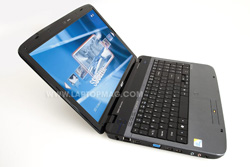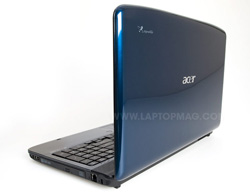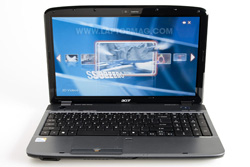Laptop Mag Verdict
This attractive 3D notebook adds a new dimension to digital entertainment for an affordable price.
Pros
- +
Attractive design
- +
Fun 3D screen for movies and mainstream games
- +
Above-average graphics performance
- +
Loud and clear speakers
Cons
- -
Struggles with the most demanding games
- -
Hard to find 3D-enabled apps
- -
Below-average battery life
- -
Limited tech support hours
Why you can trust Laptop Mag
Green Testing

Click to enlargeIt took 2 hours and 2 minutes to charge the 5738DG up to 100 percent battery capacity (which was a little swifter than the category average of 2 hours and 16 minutes), and the system used an average of 56 watts during that time. The notebook's LAPTOP Battery Efficiency Rating (the total amount of watts it takes to recharge divided by the battery life; lower is better) was 33.3--less efficient than the typical mainstream notebook (44.8).
Software and Warranty
Aside from the aforementioned TriDef utilities for 3D entertainment, preinstalled on the 5738DG is Acer GameZone, Adobe Reader 9, Microsoft Office & Home Student 2007 (60-day trial), Microsoft Works, and a 30-day trial of Norton Online Backup. Acer covers the system with a one-year limited warranty and toll-free phone support on Mon--Fri from 8 a.m. to 10 p.m.; Saturday 9 a.m. to 7 p.m.; and Sun 10 a.m. to 6 p.m. (EST). To find out how Acer fared in our annual Tech Support Showdown, click here.
Verdict
Acer has beat other notebook makers to the punch with the first affordable 3D laptop. Not only is the Aspire 5738DG a well-rounded notebook that provides plenty of style and power, but it offers a next-generation feature for less than $800. Gamers may want to hold off until laptops arrive with Nvidia's more robust (but more expensive) 3D Vision technology, but overall the 5738DG is a good first stab at 3D entertainment.
Performance
A 2.2-GHz Intel Core 2 Duo T6600 processor and 4GB of 667-MHz DDR2 RAM (expandable to 8GB) powered the 5738DG to a very good PCMark Vantage score of 4,166, about 900 points higher than the mainstream notebook average. This was considerably better than the scores notched by the Gateway NV (3,262) and Sony VAIO NW (3,334).
A 320GB hard drive (spinning at 5,400 rpm) booted the 64-bit Windows 7 Home Premium operating system in 57 seconds, nearly on a par with the category average. When we ran our LAPTOP Transfer Test (which copies a folder containing 4.97GB of mixed media from one area of the drive to another), we saw a data transfer speed of 21.9 MBps, which was 2.0 MBps faster than the average mainstream machine.
Graphics Performance
The 5738DG proved to be a decent gaming notebook, thanks to ATI's Radeon HD 4570 graphics card (with 512MB of dedicated video memory). The machine achieved a 3DMark06 score of 3,018, which was 190 points less than the mainstream average (3,208), but far higher than the Gateway NV (942) and the Sony VAIO NW (1,000), two systems that feature Intel's integrated graphics.

Click to enlargeWith the resolution set to 1024 x 768, the 5738DG was able to handle the graphically demanding Far Cry 2, moving at a solid 42 frames per second. This is much better than what the Gateway NV (5 fps) and Sony VAIO NW (6 fps) produced at the same resolution. However, that number dipped to just 14 fps when we bumped the pixel count up to 1366 x 768 and increased the eye candy to maximum.
In World of Warcraft, the system notched 52 fps with the resolution set to 1024 x 768, dropping to 35 fps at its native resolution. When playing Left 4 Dead, action was somewhat choppy at 1366 x 768; we had better success when we decreased the resolution to 1270 x 720.
The 5738DG was able to transcode a 114MB MPEG-4 file to AVI using HandBrake in 7 minutes and 18 seconds, which was 18 seconds faster than the mainstream notebook average. This time just beat out the Sony VAIO NW (7:22) and the Gateway NV (7:20). It also flawlessly played back a 1:59 clip of Terminator 2: Judgment Day (1080p).
Wi-Fi and Battery Life
Intel's WiFi Link 5100 802.11b/g/n card pushed data along at a rate of 19.7 Mbps at 15 feet away from our access point, and 16.4 Mbps at 50 feet. Not only were these numbers on a par with the mainstream wireless averages (20.1 and 16.8 Mbps), but the strong signal permitted us to stream full-screen HD episodes of The Simpsons over Hulu without any issues.
When we ran our LAPTOP Battery Test (continuous Web-surfing over Wi-Fi), the 5738DG lasted 3 hours and 25 minutes before losing its charge, which was 6 minutes shorter than the mainstream notebook average, but nearly the same as the Gateway NV and Sony VAIO NW. This system lasted about half an hour longer than the touchscreen Acer 5738PG.
3D Features

Click to enlargeWhat separates the 5738DG from other mainstream notebooks is its 3D-enabled display, built by TriDef. In order for users to properly see 3D renderings on screen, they have to wear polarized glasses. Acer bundles a pair of 3D glasses with the notebook, as well as a pair of Dwayne Wayne-esque flip-down shades. We found the glasses--which, as cheap 3D glasses go, aren't all that ugly--to be more effective than the flip-down shades at bringing out images. More importantly, we found them comfortable to wear for an extended period of time.
While horizontal viewing angles for the 3D screen are pretty wide--about 170 degrees--vertical viewing angles are fairly narrow; the mere act of sitting up very straight or slouching throws images out of whack.
A good deal of applications are compatible with the 3D screen; it's just not easy figuring out which ones they are. There's no shortcut on the 5738DG pointing you to a list of games or titles. While there's nothing in the way of info on Acer's site, a number of games are listed on TriDef's Web site. Finding the list of games was a bit of a pain, but we were pleased to see that there were about 120 titles listed, from casual (The Sims 2) to more graphically demanding (Far Cry 2). However, as we found out, the graphics card in the 5738DG is better suited for middle-of-the-road games (more on that later).
TriDef's 3D Ignition utility will automatically scan the computer for any installed programs that will work with the screen, which you must then launch through Ignition.
When we flew in World of Warcraft, it was neat to see the tail of our Dragonhawk as we flew from place to place, as well as the terrain unfolding beneath us. Zombies coming straight at us in Left 4 Dead were a bit more terrifying. Ironically, aiming proved more difficult: Our Uzi seemed to float in front of us in space, and we had a harder time judging how much to move the reticle, especially for targets farther away.
In Google Earth, it was neat to see the 3D buildings in actual 3D: when flying over Manhattan, they really did rise from the sidewalk to meet us. However, the icons for Places and businesses seemed to float freely, and proved distracting; best to turn them off. Also, side menus, which are not affected by TriDef's utility, are nearly impossible to read while wearing the glasses.
Another nice feature of the TriDef software is the ability to convert DVDs into 3D. We played DVDs of Aeon Flux and Finding Nemo using TriDef's 3D utility; two slider bars let you adjust how much 3D-ness you want by changing the overall depth and amount the images appear in front of the screen (move them both too far to the right, and you'll get a migraine quickly). The TriDef software worked fairly well--the seascapes in Finding Nemo were especially vivid--but characters don't jump out of the screen as they do in theaters.
Ports and Webcam
The Aspire 5738DG includes plenty of connections for attaching accessories and peripherals: four USB 2.0, HDMI, VGA, S/PDIF, 5-in-1 memory card reader, Ethernet, modem, headphone, and microphone. Acer also includes an 8X DVD drive for watching movies, loading software, burning discs, and other activities.
Above the display is Acer's 1.3-megapixel Crystal Eye webcam. When chatting with friends over Meebo, they reported seeing clear images with good color balance that only suffered from motion blurs when we moved about too quickly.

Click to enlarge

Click to enlarge
Editor's Note: Portions of this review were taken from our earlier coverage of the Acer Aspire 5738PG.
It seems that Acer is using its Aspire 5738 as something of a testbed for new technology. First came the touch-enabled 5738PG, and now the 5738DG features 3D technology. Used in conjunction with a pair of polarized glasses, the company is aiming to bring the 3D movie theater experience down to a personal level. What's better, even for a first attempt, is that it largely succeeds. While there are kinks to be worked out--it would help if there was a 3D app or content portal of some sort--Acer has put together a robust system for $779.
Design
Measuring 15.1 x 9.9 x 1.5 inches and weighing 6.1 pounds, the 5738DG is a tad bulkier and heavier than the 5.6-pound, 14.6 x 9.8 x 1.5-inch Gateway NV, as well as the 5.6-pound, 14.6 x 9.8 x 1.2-inch Sony VAIO NW. The system sports Acer's classy Gemstone design, which incorporates a dark blue lid (attracting a light amount of fingerprints and smudges), a charcoal gray base (featuring a granulated dot pattern), and black accents throughout.
To the upper-left of the keyboard are easily accessible on/off buttons for Bluetooth and Wi-Fi, an illuminated power button, and the Acer Backup Manager button (which lets users create automatic backup profiles). Adjacent to those are status indicator lights, and to the far right you'll find dedicated volume keys, along with a user-definable shortcut button. A microphone is positioned dead in the middle.
Keyboard and Touchpad
The wide base of the 5738DG affords a roomy and comfortable keyboard with firm, chiclet-style keys that made it easy to tap out documents, e-mails, and URLs. We appreciated the large Shift keys and full number pad. Using the touchpad, we could two-finger swipe through photos, and use pinch gestures to zoom in and out of images. The mouse buttons were quite mushy, and didn't offer much in the way of feedback. A button to the right of the touchpad allows you to disable it when pressed, and a biometric fingerprint reader is nestled between the mouse buttons to keep data away from prying eyes.
Display and Audio
The high-definition 15.6-inch, 1366 x 768-pixel display provided sharp visuals when we loaded up a DVD of Aeon Flux. Dark scenes and clothing had plenty of richness without being overbearing, but the screen's glossy coating kicks back a fair amount of reflections.
The Dolby Home Theater speakers (positioned north of the keyboard) served up very clean and loud sound. While listening to Curtis Mayfield's "Wild and Free," we marveled at the crispness of the horns and the separation from the high and low-end sounds that were delivered by the Virtual SurroundSound technology. The bass wasn't as robust as Acer's own machines that feature CineBass (such as the Acer Aspire 8920G), but the 5738DG certainly sounds better than other notebooks in this price range.
Acer Aspire 5738DG Specs
| Brand | Acer |
| CPU | 2.2-GHz Intel Core 2 Duo T6600 |
| Card Slots | 5-1 card reader |
| Company Website | http://us.acer.com |
| Display Size | 15.6 |
| Graphics Card | ATI Radeon HD 4570 |
| Hard Drive Size | 320GB |
| Hard Drive Speed | 5,400rpm |
| Hard Drive Type | SATA Hard Drive |
| Native Resolution | 1366x768 |
| Operating System | MS Windows 7 Home Premium (64-bit) |
| Optical Drive | DVD /-RW DL |
| Optical Drive Speed | 8X |
| Ports (excluding USB) | Microphone, Headphone, HDMI, Ethernet, VGA, S/PDIF, Modem |
| RAM | 4GB |
| RAM Upgradable to | 8GB |
| Size | 15.1 x 9.9 x 1.5 inches |
| USB Ports | 4 |
| Video Memory | 512MB |
| Warranty/Support | One-year limited/Mon--Fri 8 a.m. to 10 p.m., Saturday 9 a.m. to 7 p.m., Sun 10 a.m. to 6 p.m. (EST) toll free phone |
| Weight | 6.1 pounds |
| Wi-Fi | 802.11b/g/n |
